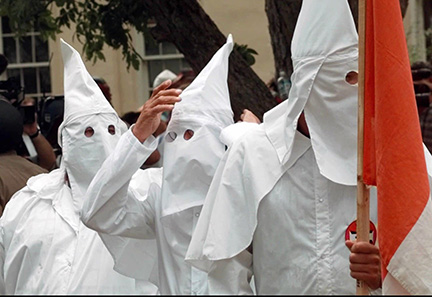By D.R. Adams
The United States of America is witnessing 21st century-style Ku Klux Klan operations, perpetrated at the very highest levels in our society.
Clearly, the objectives are to deny equal citizenship, suppress the vote, and disenfranchise people of color. Resurging and promoting a “white supremacist” ideology parallel to the 1870s during Reconstruction defines their motives, then and now.
Essentially, this Klan style playbook is waging a campaign of intimidation, violence, and misinformation aimed at casting fear and doubt regarding the integrity and administration of our electoral process. This ridiculous Klan clown show is rapidly spreading across the nation, doing great harm to America’s democracy.
Since its founding in 1865, at the end of the Civil War, the Klan experienced several periods of expansion, setbacks, and resurgence. In 1871, Congress passed the Ku Klux Klan Act which significantly reduced Klan activity in the South.
Voter suppression, disenfranchisement, fear, and chaos leveled by the Klan led to Democratic control of the South and the end of Reconstruction in 1876. The political gains achieved by Black Americans after the war eroded as a result of the Klan and its co-conspirators. Fear combined with state-sponsored Jim Crow laws and Black Codes created a long void of Black participation in America’s political process in the late 19th and early 20th centuries.
“The Birth of a Nation,” a 1915 film degrading Black people and glorifying the Ku Klux Klan, is credited with spearheading the second coming of the organization. President Woodrow Wilson welcomed the screening of “The Birth of a Nation” at the White House in 1915. Inspired by the film, William J. Simmons, a Methodist preacher from Atlanta became a leader and Imperial Wizard of the Ku Klux Klan. He targeted African Americans, Mexicans, Jews, Catholics, and Asians as un-American to recruit Klan members. As immigrants and Black soldiers returned home to America after World War I, racism raised its ugly head leading to murder, the lynching of Black people, and race riots throughout the country.
Simultaneously, membership in the Ku Klux Klan expanded to its highest ever- over four million Klan members. The Klan’s mission remained as in 1865: promoting “white supremacy” by committing violence, intimidation, misinformation, and domestic terrorism against people of color and white sympathizers.
The tactics implemented by Klan members in 1865 mirror ones deployed by white supremacists, violent organizations such as the Proud Boys and neo-Nazi hate groups in the 21st century.
In the aftermath of WWII, Black soldiers returned to an America that refused to accept them as equal citizens despite their bravery and exemplary service in winning the war.
In the mid-twentieth century, a series of events, including the 1954 Supreme Court school desegregation decision, Brown vs. Board of Education, the brutal murder of a young Black boy, Emmitt Till in 1955, and Rosa Park’s refusal to give up her seat on a Montgomery bus, triggered the development and growth of the Civil Rights Movement.
At the heart of the Civil Rights Movement agenda in the 1960s were ending racial discrimination, enfranchising Black people, and tackling racial segregation.
Congress passed the Civil Rights Act in 1964, providing a legal platform for addressing racial discrimination in employment, education, housing and public accommodations. Simultaneously, the right for Black people to vote presented a host of other challenges. Theoretically, the 15th amendment to the Constitution in 1870 granted Black men that right. When Congressman John Lewis and fellow patriots marched to Selma, Alabama in 1965, the police attacked them, resulting in “Bloody Sunday.” These events gained traction and media attention, leading to Congress passing the Voting Rights Act that year.
It took America 95 years to pass the Voting Rights Act of 1965 to end legal voter discrimination and suppression.
Meanwhile, in 2013, the Supreme Court gutted the 1965 Voting Rights Act by granting some southern states the power to change election laws without federal approval. This, in effect, gave states a blank check to implement voter suppression measures that included; voter ID laws, limiting the number of polling places, and proof of citizenship.
The Supreme Court in 1883, by an 8 to 1 decision ruled that the 13th and 14th amendments to the Constitution didn’t give Congress the power to outlaw racial discrimination by private individuals. In other words, the 1875 Civil Rights Act that prohibited racial discrimination at hotels, trains, and other public places was null and void. Essentially the United States Court system executed the Klan’s playbook. Not by burning a cross, lynching a Black person, or setting fire to a home, but simply by signing a document into law.
Black people make up 12 to 13% of America’s population; however, Black males represent nearly 35% of those imprisoned. The brutal and insensitive murders of Eric Garner in New York and George Floyd in Minnesota might be viewed as Klan style executions. In this America, little immigrant children can be separated from their parents and treated as less than human. It sounds like a policy adopted by the Klan in 1915.
Recently, on January 6, 2021, a Klan-style mob attacked the Nation’s capital, destroying federal property, threatening the lives of congresspeople, their staff, killing at least five people, and endangering the very fabric of our democracy. This insurrectionist coup attempt included confederate flags; hanging nooses and chants of “hang Mike Pence,” Vice President of the United States.
A divided America is an unhealthy America. White supremacy, racism, sexism, bigotry, anti-immigration, and individuals, institutions, and organizations which espouse such, undermine the fabric of a healthy America. Dr. Martin Luther King, Jr. once said, “We are not makers of history. We are made by history.”
By researching and documenting the history and culture of the Ku Klux Klan, we can implement the necessary changes required to develop the healing process in America.



